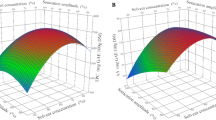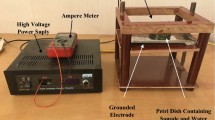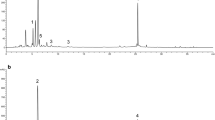Abstract
The aim of the current research is to study the effect of parameters including: extraction time (sonication time), extraction temperature, and drying method on the extraction yield of phenolics from water mint (Mentha aquatica) under ultrasonic irradiation. Therefore, three drying methods (microwave-drying, oven-drying, and freeze-drying) were performed. The dried samples were then ground and extracted at three different temperatures (20, 40, and 60 °C) in an ultrasonic bath. The maximum total phenolic compounds (TPCs) of 0.2451 mg/g were attained by freeze-drying method regarding the following process conditions: the extraction time of 5 min, and the extraction temperature of 60 °C. The results demonstrated that the drying method and temperature, respectively, are the most effective parameters in the extraction of phenolic compounds from Mentha aquatica. Besides, observations indicated that sonication (under 42 kHz and 160 W sonication condition) would not bring any sensible effect on the extraction yield. Additionally, a cost evaluation of presented experiments has been made to investigate the economical evaluation. The calculations showed that the consumed electrical power in freeze-drying method is very high which would not be cost effective.




Similar content being viewed by others
References
Aydin E, Gocmen D (2015) The influences of drying method and metabisulfite pre-treatment on the color, functional properties and phenolic acids contents and bioaccessibility of pumpkin flour. LWT Food Sci Technol 60:385–392
Barba FJ, Zhu Z, Koubaa M, Sant’Ana AS, Orlien V (2016) Green alternative methods for the extraction of antioxidant bioactive compounds from winery wastes and by-products: a review. Trends Food Sci Technol 49:96–109. https://doi.org/10.1016/j.tifs.2016.01.006
Barba FJ, Putnik P, Bursać Kovačević D, Poojary MM, Roohinejad S, Lorenzo JM, Koubaa M (2017) Impact of conventional and non-conventional processing on prickly pear (Opuntia spp.) and their derived products: from preservation of beverages to valorization of by-products. Trends Food Sci Technol 67:260–270. https://doi.org/10.1016/j.tifs.2017.07.012
Bilek SE (2010) The effects of time, temperature, solvent: solid ratio and solvent composition on extraction of total phenolic compound from dried olive (Olea europaea L.) leaves. GIDA J Food 35:411–416
Chen D, Weavers LK, Walker HW (2006) Ultrasonic control of ceramic membrane fouling by particles: effect of ultrasonic factors. Ultrason Sonochem 13:379–387
Dorman HJ, Kosar M, Kahlos K, Holm Y, Hiltunen R (2003) Antioxidant properties and composition of aqueous extracts from Mentha species, hybrids, varieties, and cultivars. J Agric Food Chem 51:4563–4569. https://doi.org/10.1021/jf034108k
Ghafoor K, Choi YH, Jeon JY, Jo IH (2009) Optimization of ultrasound-assisted extraction of phenolic compounds, antioxidants, and anthocyanins from grape (Vitis vinifera) seeds. J Agric Food Chem 57:4988–4994
Hussein SR, Abdel Latif RR, Marzouk MM, Elkhateeb A, Mohammed RS, Soliman AAF, Abdel-Hameed E-SS (2018) Spectrometric analysis, phenolics isolation and cytotoxic activity of Stipagrostis plumosa (Family Poaceae). Chem Papers 72:29–37. https://doi.org/10.1007/s11696-017-0254-0
Kamkar A, JebeliJavan A, Jamshidi R (2009) Antioxidant capacity of essential oil and extract of Iranian Mentha spicat. J Vet Lab Res 1:69–77. https://doi.org/10.22075/jvlr.2017.797
Leighton T (1994) 5—Effects and mechanisms. In: Leighton T (ed) The acoustic bubble, Academic Press, pp 439–590. https://doi.org/10.1016/B978-0-12-441920-9.50010-9
Lin J-K, Liang Y-C, Lin-Shiau S-Y (1999) Cancer chemoprevention by tea polyphenols through mitotic signal transduction blockade. Biochem Pharmacol 58:911–915
Liyana-Pathirana C, Shahidi F (2005) Optimization of extraction of phenolic compounds from wheat using response surface methodology. Food Chem 93:47–56
Lopes AP, Petenuci ME, Galuch MB, Schneider VVA, Canesin EA, Visentainer JV (2018) Evaluation of effect of different solvent mixtures on the phenolic compound extraction and antioxidant capacity of bitter melon (Momordica charantia). Chem Pap 72:2945–2953
Mukhtar H, Ahmad N (2000) Tea polyphenols: prevention of cancer and optimizing health. Am J Clin Nutr 71:1698S–1702S
Nguyen VT, Van Vuong Q, Bowyer MC, Van Altena IA, Scarlett CJ (2015) Effects of different drying methods on bioactive compound yield and antioxidant capacity of Phyllanthus amarus. Drying Technol 33:1006–1017. https://doi.org/10.1080/07373937.2015.1013197
Nunes JC, Lago MG, Castelo-Branco VN, Oliveira FR, Torres AG, Perrone D, Monteiro M (2016) Effect of drying method on volatile compounds, phenolic profile and antioxidant capacity of guava powders. Food Chem 197:881–890
OrphAnides A, GOulAs V, GekAs V (2013) Effect of drying method on the phenolic content and antioxidant capacity of spearmint. Czech J Food Sci 31:509–513
Oussaid S, Madani K, Houali K, Rendueles M, Diaz M (2018) Optimized microwave-assisted extraction of phenolic compounds from Scirpus holoschoenus and its antipseudomonal efficacy, alone or in combination with Thymus fontanesii essential oil and lactic acid. Food Bioprod Process 110:85–95
Patra JK, Das G, Lee S, Kang S-S, Shin H-S (2018) Selected commercial plants: a review of extraction and isolation of bioactive compounds and their pharmacological market value. Trends Food Sci Technol 82:89–109. https://doi.org/10.1016/j.tifs.2018.10.001
Pietrzak W, Nowak R, Olech M (2014) Effect of extraction method on phenolic content and antioxidant activity of mistletoe extracts from Viscum album subsp. abietis. Chemical Pap 68:976–982. https://doi.org/10.2478/s11696-013-0524-4
Revilla E, Ryan J-M, Martín-Ortega G (1998) Comparison of several procedures used for the extraction of anthocyanins from red grapes. J Agric Food Chem 46:4592–4597
Roosta M, Ghaedi M, Daneshfar A, Sahraei R, Asghari A (2014) Optimization of the ultrasonic assisted removal of methylene blue by gold nanoparticles loaded on activated carbon using experimental design methodology. Ultrason Sonochem 21:242–252
Roy RA (1999) Cavitation sonophysics. In: Crum LA, Mason TJ, Reisse JL, Suslick KS (eds) Sonochemistry and sonoluminescence. Springer, Dordrecht, pp 25–38. https://doi.org/10.1007/978-94-015-9215-4_2
Santos SA, Villaverde JJ, Silva CM, Neto CP, Silvestre AJ (2012) Supercritical fluid extraction of phenolic compounds from Eucalyptus globulus Labill bark. J Supercrit Fluids 71:71–79
Shadmehr J, Mirsoleimani-azizi SM, Zeinali S, Setoodeh P (2018) Electrocoagulation process for propiconazole elimination from wastewater: experimental design for correlative modeling and optimization. Int J Environ Sci Technol. https://doi.org/10.1007/s13762-018-1891-8
Singleton VL, Rossi JA (1965) Colorimetry of total phenolics with phosphomolybdic–phosphotungstic acid reagents. Am J Enol Vitic 16:144–158
Thangapazham RL, Singh AK, Sharma A, Warren J, Gaddipati JP, Maheshwari RK (2007) Green tea polyphenols and its constituent epigallocatechin gallate inhibits proliferation of human breast cancer cells in vitro and in vivo. Cancer Lett 245:232–241
Vu HT, Scarlett CJ, Vuong QV (2017) Effects of drying conditions on physicochemical and antioxidant properties of banana (Musa cavendish) peels. Dry Technol 35:1141–1151
Acknowledgements
The authors acknowledge the funding support of Babol Noshiravani University of Technology through Grant Program no. BNUT/370,675/97.
Author information
Authors and Affiliations
Corresponding author
Ethics declarations
Conflict of interest
On behalf of all the authors, the corresponding author states that there is no conflict of interest.
Additional information
Publisher's Note
Springer Nature remains neutral with regard to jurisdictional claims in published maps and institutional affiliations.
Rights and permissions
About this article
Cite this article
Safaiee, P., Taghipour, A., Vahdatkhoram, F. et al. Extraction of phenolic compounds from Mentha aquatica: the effects of sonication time, temperature and drying method. Chem. Pap. 73, 3067–3073 (2019). https://doi.org/10.1007/s11696-019-00843-5
Received:
Accepted:
Published:
Issue Date:
DOI: https://doi.org/10.1007/s11696-019-00843-5




